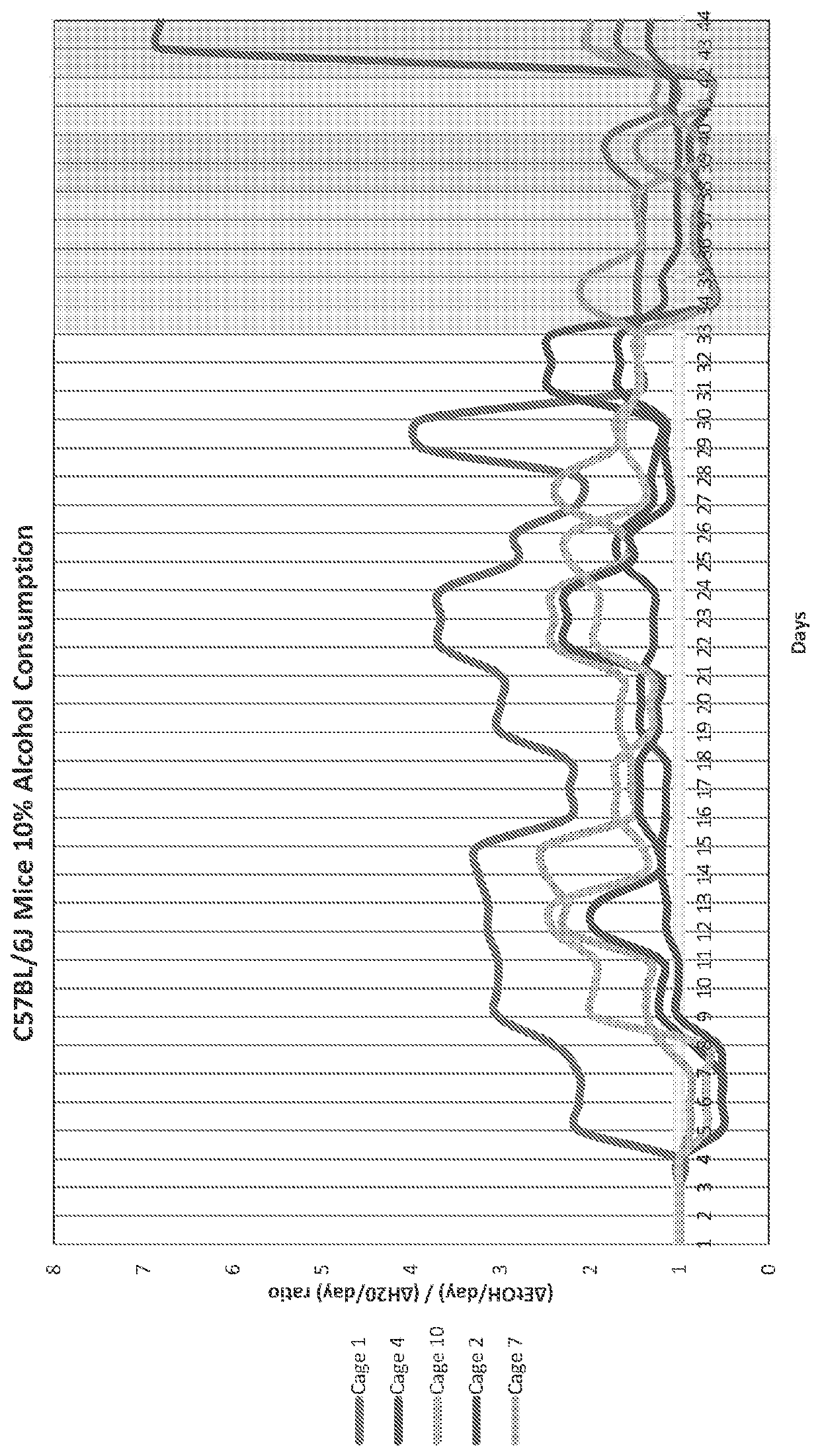Methods of treating alcohol abuse disorder
a technology of alcohol abuse and treatment methods, applied in the field of treatment methods of alcohol abuse disorders, can solve the problems of alcohol-dependent people often inability to stop drinking, significant and recurrent adverse effects, etc., and achieve the effects of reducing alcohol consumption, reducing alcohol consumption, and reducing alcohol consumption
- Summary
- Abstract
- Description
- Claims
- Application Information
AI Technical Summary
Benefits of technology
Problems solved by technology
Method used
Image
Examples
example 1
erapy for the Treatment of Alcohol Abuse Disorder
[0131]Animals (C57BL / 6J mice) were offered two options for drinking water, one bottle with pure water, and the other bottle containing a 10% ethanol / water mix, both of which were available “free choice” from Day 1 of the experiment. The males of this strain of mice are known to demonstrate a preference for alcohol when it is available to them. In this experiment, as the mice became accustomed to the 10% ethanol mix offered, they began to drink more and more of the ethanol mix, so that when their liquid consumption was plotted as a ratio of 10% ethanol / water, the ratio quickly became greater than 1 (more 10% ethanol than pure water). The mice were allowed to establish a baseline consumption pattern, and after 30 Days, 5 cages consistently consumed more of the ethanol mix than pure water.
[0132]Beginning on Day 33, three cages were treated with Spexin at 25 micrograms / kg / day in 1×PBS; via IP injection (cages 1, 4, and 10). Mice were admi...
example 2
duces Ethanol Consumption in Mice
[0134]Spexin is a novel human adipokine that produces weight loss when injected into obese (DIO) mice. Its mechanisms of action include central effects, e.g. appetite suppression, mediated by the GALR2 receptor, and direct, local inhibition of long chain fatty acid (LCFA) uptake by adipocytes. By contrast, galanin is a structurally related adipokine that, by interaction with GALR2, increases appetite in mice, especially for fatty foods, and also stimulates ethanol intake. Spexin's appetite-reducing effects are mediated by competition with galanin for binding to GALR2. This suggested that galanin's stimulatory effects on ethanol intake might also be reduced by spexin.
[0135]To test this hypothesis, 5 groups of 5 male C57BL / 6J mice (25 total) were housed for 40 days in plastic cages with 2 water bottles each: one containing water and the other 10% ethanol in water (10% ethanol). Fluids were available “free choice”, and intake from each bottle was record...
PUM
| Property | Measurement | Unit |
|---|---|---|
| temperatures | aaaaa | aaaaa |
| temperatures | aaaaa | aaaaa |
| temperatures | aaaaa | aaaaa |
Abstract
Description
Claims
Application Information
 Login to View More
Login to View More - R&D
- Intellectual Property
- Life Sciences
- Materials
- Tech Scout
- Unparalleled Data Quality
- Higher Quality Content
- 60% Fewer Hallucinations
Browse by: Latest US Patents, China's latest patents, Technical Efficacy Thesaurus, Application Domain, Technology Topic, Popular Technical Reports.
© 2025 PatSnap. All rights reserved.Legal|Privacy policy|Modern Slavery Act Transparency Statement|Sitemap|About US| Contact US: help@patsnap.com

